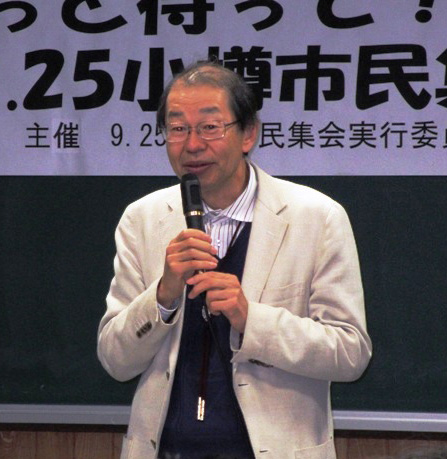Anti-Nuke Who’s Who “Citizen science for the benefit of citizens!” Yugo Ono, A Geographer Who Fights
by Jin Satoko*
 |
|
Dr. Yugo Ono
|
Yugo Ono is a cousin of Yoko Ono. This is not widely known, and before I learned about this, I had not known much about him. After the March 11, 2011 earthquake, I organized a gathering with friends to discuss the potential danger of the Tomari Nuclear Power Station in Hokkaido. We invited Dr. Ono as a speaker for the gathering. I remember that I was looking forward to seeing the cousin of Yoko Ono.
On the day of the gathering, Dr. Ono, wearing a hunting cap, which is his trademark, seemed to me like a tall, thin “daddy-long-legs.” In spite of this appearance and a quiet speaking voice, he delivered a talk backed up by strong beliefs and scientific evidence, keenly impressing the audience.
Dr. Ono is deeply influenced by the late Jinzaburo Takagi. Through one of Takagi’s books, Living as a Citizen Scientist, Dr. Ono learned the way of living as a citizen scientist and became convinced of what he was trying to achieve.
Dr. Ono came to be involved in the issue of nuclear power when he became aware of the problem of high-level radioactive waste disposal. What technocrats asserted contradicted what he had written in a geography textbook. The Atomic Energy Society of Japan sent objections about the descriptions concerning nuclear power in the junior and senior high school geography textbooks, pointing out minute details that sounded critical of nuclear power. As a geographer, he could not remain silent and started to speak up. Thus Dr. Ono became a geographer who fights.
After the Fukushima Daiichi Nuclear Power Station accident, Dr. Ono was extremely concerned about the behavior of the government, and promptly spoke to the Science Council of Japan to encourage scientists to speak up. He also believed that Sapporo, which was not damaged by the accident, should support victims, and established the Citizens’ Network for Support of Victims of the Great East Japan Earthquake (dubbed “Musubiba”), to offer support to the areas hit by the quake and accident. He also later started to support evacuees from Fukushima at the same time.
Dr. Ono estimates that if an accident occurred at the Tomari NPP, Hokkaido, where winds blow from the west, would be totally devastated. “In the 1993 southwest Hokkaido offshore earthquake, it was learned that an active fault runs very close to the Tomari NPP,” he stresses. “The NPP must not be restarted.” He established the Group for Decommissioning the Tomari NPP, and has filed a lawsuit aimed at the decommissioning of the NPP. To gather plaintiffs, he made a speaking tour around Hokkaido, giving 15 talks in three months. The gathering we organized, mentioned above, was one of them, and of course I joined the group as a plaintiff.
Dr. Ono also emphasizes that the precautionary principle should be applied to nuclear power plants. According to this principle, the entity that is responsible for any conduct must prove that it does no harm, and if harm or damage does arise, the entity is then responsible for making reparations; the entity must prove that the conduct is not associated with the harm.
Dr. Ono also studies rivers, and as part of the activities as a river researcher, he participates as an environmental scientist in the action against the Chitosegawa River water discharge channel construction project. In addition, he participates in the movement to restore the rights of indigenous Ainu people and the movement against the Sanru Dam construction. He is active in many fields.
Dr. Ono was born in Tokyo in 1948. He specialized in geological science at university. Today, he is professor emeritus at Hokkaido University, and professor at Hokusei Gakuen University, Sapporo, Hokkaido.
*Representative of Otaru Group of Parents Concerned about Children’s Environment

